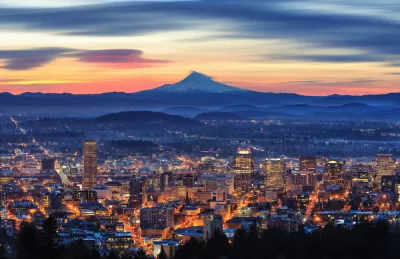Undoing Oregon’s urban growth boundaries won’t solve the state’s housing crisis, an opinion piece argues. Smart growth lies within existing cities.

An opinion piece by Sam Diaz, Kim McCarty and Steve Messinetti in The Oregonian argues against removing the state’s urban growth boundaries, which restrict development within a certain geographic area around each city.
The piece is written in response to a November 12 column by Steve Duin that proposed eliminating the urban growth boundary as a way to relieve the state’s housing affordability and supply crisis. According to the authors, Duin’s suggestion “will not result in housing options near existing schools, parks, jobs, stores and services that most Oregonians can afford.”
As the authors explain, “The urban growth boundary is an innovative policy for designating land for development that continues to achieve its goals of preventing climate-harming and congestion-inducing sprawl while protecting land that grows our food and offers us moments in nature.” The article points out that cities without urban growth boundaries aren’t faring any better when it comes to the housing crisis, and that ignoring growth boundaries would promote sprawl.
The real solution, the authors write, is more complex. “We need a comprehensive approach that includes stabilizing renters at risk of eviction, land use policies that encourage density near jobs and transportation, funding to close racial disparities in home ownership, fast-track permitting and fee waivers to encourage affordable housing, and increasing availability of underutilized land within urban growth boundaries.”
FULL STORY: Opinion: Undoing urban growth boundary isn’t the answer to our housing crisis

Florida Considers Legalizing ADUs
Current state law allows — but doesn’t require — cities to permit accessory dwelling units in single-family residential neighborhoods.

Manufactured Crisis: Losing the Nation’s Largest Source of Unsubsidized Affordable Housing
Manufactured housing communities have long been an affordable housing option for millions of people living in the U.S., but that affordability is disappearing rapidly. How did we get here?

Americans May Be Stuck — But Why?
Americans are moving a lot less than they once did, and that is a problem. While Yoni Applebaum, in his highly-publicized article Stuck, gets the reasons badly wrong, it's still important to ask: why are we moving so much less than before?

EV Chargers Now Outnumber Gas Pumps by Nearly 50% in California
Fast chargers still lag behind amidst rapid growth.

Affordable Housing Renovations Halt Mid-Air Amidst DOGE Clawbacks
HUD may rescind over a billion dollars earmarked for green building upgrades.

Has Anyone at USDOT Read Donald Shoup?
USDOT employees, who are required to go back to the office, will receive free parking at the agency’s D.C. offices — flying in the face of a growing research body that calls for pricing parking at its real value.
Urban Design for Planners 1: Software Tools
This six-course series explores essential urban design concepts using open source software and equips planners with the tools they need to participate fully in the urban design process.
Planning for Universal Design
Learn the tools for implementing Universal Design in planning regulations.
City of Moreno Valley
Institute for Housing and Urban Development Studies (IHS)
City of Grandview
Harvard GSD Executive Education
NYU Wagner Graduate School of Public Service
City of Cambridge, Maryland
Newport County Development Council: Connect Greater Newport





























